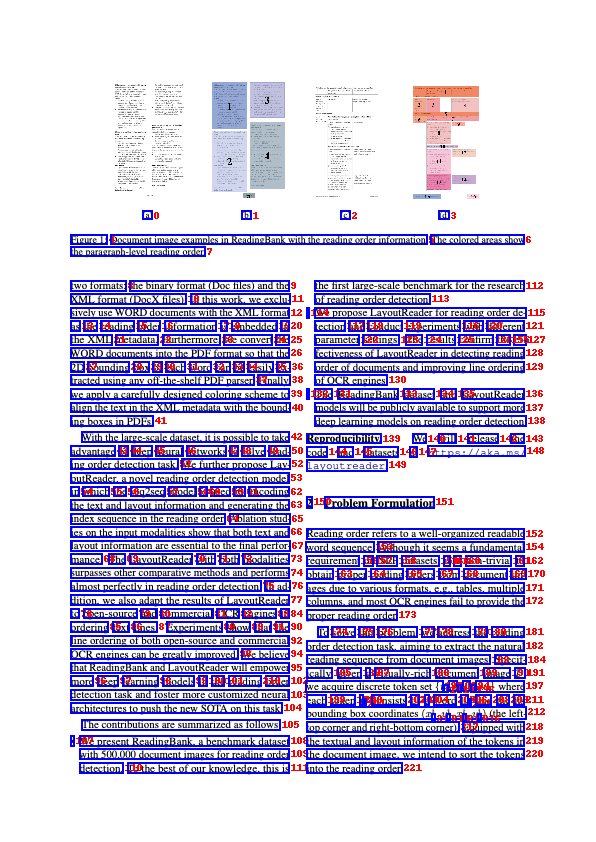- 1C++/CLI 托管C++的数组介绍【4】_gcnew 数组
- 2易基因|典型案例:MeRIP-seq综合分析肺腺癌中的转录组m6A甲基化组_cgmp-pkg信号途径和肿瘤的关系
- 3动态规划:凸多边形最优三角剖分算法思路及代码分析(Java)_java 三角刨分
- 4如何把java程序打成JAR包并能自动运行_java程序自动打成jar包
- 5鲁能巴蜀中学自研chatGPT
- 6python、golang、java、c++,rust如何选择?_rust vs golang python
- 7Ubuntu 14.04/14.10下安装VMware Workstation 11图文教程
- 8太厉害了!BIO和NIO有啥区别?细节爆炸_nio 坏处
- 9pycharm安装第三方库:Try to run this command from the system terminal. Make sure that you use the问题,亲测已解决
- 10多语言多方式调用1688平台API接口获取商品/店铺详情_阿里巴巴创建采购订单api
【文档智能】符合人类阅读顺序的文档模型-LayoutReader原理及权重开源
赞
踩
引言
阅读顺序检测旨在捕获人类读者能够自然理解的单词序列。现有的OCR引擎通常按照从上到下、从左到右的方式排列识别到的文本行,但这并不适用于某些文档类型,如多栏模板、表格等。LayoutReader模型使用seq2seq模型捕获文本和布局信息,用于阅读顺序预测,在实验中表现出色,并显著提高了开源和商业OCR引擎在文本行排序方面的表现。
一、LayoutReader模型

1.1 编码器(Encoder)
LayoutReader使用LayoutLM的布局模型作为编码器。在编码阶段,LayoutReader将源序列和目标序列打包成一个连续的输入序列,并设计了自注意力掩码来控制token之间的可见性。具体来说,LayoutReader允许源序列中的标记相互关注,同时阻止目标序列中的标记关注右侧上下文。
自注意力掩码
M
M
M的设计:
M
i
,
j
=
{
1
if
i
<
j
or
i
,
j
∈
src
0
otherwise
M_{i,j} =
其中,
i
i
i和
j
j
j是打包输入序列中的索引,可能来自源或目标序列;
i
,
j
∈
s
r
c
i, j ∈ src
i,j∈src表示两个标记都来自源序列。
1.2 解码器(Decoder)
在解码阶段,由于源序列和目标序列是重新排序的序列,预测候选可以被限制在源序列内。因此,模型被要求预测源序列中的索引。概率计算如下:

其中, i i i是源序列中的索引;$e_i 和 和 和e_j 分别是源序列的第 分别是源序列的第 分别是源序列的第i 个和第 个和第 个和第j 个输入嵌入 ( i n p u t e m b e d d i n g s ) ; 个输入嵌入(input embeddings); 个输入嵌入(inputembeddings);h_k 是第 是第 是第k 步的隐藏状态 ( h i d d e n s t a t e s ) ; 步的隐藏状态(hidden states); 步的隐藏状态(hiddenstates);b_k 是第 是第 是第k$步的偏置(bias)。
二、实验
进行了三个实验来评估LayoutReader在ReadingBank上的表现,包括阅读顺序检测、输入顺序研究和对OCR引擎的适应性



实验结果表明,LayoutReader在阅读顺序检测任务上超越了其他基线方法,并且可以显著提高OCR引擎的文本行排序。
三、非官方开源权重
-
huggingface:https://huggingface.co/yujunhuinlp/LayoutReader-only-layout-large
-
github code(only layout):https://github.com/yujunhuics/LayoutReader
-
bbox排序
import torch from model import LayoutLMv3ForBboxClassification from collections import defaultdict CLS_TOKEN_ID = 0 UNK_TOKEN_ID = 3 EOS_TOKEN_ID = 2 def BboxesMasks(boxes): bbox = [[0, 0, 0, 0]] + boxes + [[0, 0, 0, 0]] input_ids = [CLS_TOKEN_ID] + [UNK_TOKEN_ID] * len(boxes) + [EOS_TOKEN_ID] attention_mask = [1] + [1] * len(boxes) + [1] return { "bbox": torch.tensor([bbox]), "attention_mask": torch.tensor([attention_mask]), "input_ids": torch.tensor([input_ids]), } def decode(logits, length): logits = logits[1: length + 1, :length] orders = logits.argsort(descending=False).tolist() ret = [o.pop() for o in orders] while True: order_to_idxes = defaultdict(list) for idx, order in enumerate(ret): order_to_idxes[order].append(idx) order_to_idxes = {k: v for k, v in order_to_idxes.items() if len(v) > 1} if not order_to_idxes: break for order, idxes in order_to_idxes.items(): idxes_to_logit = {} for idx in idxes: idxes_to_logit[idx] = logits[idx, order] idxes_to_logit = sorted( idxes_to_logit.items(), key=lambda x: x[1], reverse=True ) for idx, _ in idxes_to_logit[1:]: ret[idx] = orders[idx].pop() return ret def layoutreader(bboxes): inputs = BboxesMasks(bboxes) logits = model(**inputs).logits.cpu().squeeze(0) orders = decode(logits, len(bboxes)) return orders if __name__ == '__main__': bboxes = [[584, 0, 595, 1], [35, 120, 89, 133], [35, 140, 75, 152]] model_path = "" model = LayoutLMv3ForBboxClassification.from_pretrained() print(layoutreader(bboxes)) # [1, 2, 0]
- 1
- 2
- 3
- 4
- 5
- 6
- 7
- 8
- 9
- 10
- 11
- 12
- 13
- 14
- 15
- 16
- 17
- 18
- 19
- 20
- 21
- 22
- 23
- 24
- 25
- 26
- 27
- 28
- 29
- 30
- 31
- 32
- 33
- 34
- 35
- 36
- 37
- 38
- 39
- 40
- 41
- 42
- 43
- 44
- 45
- 46
- 47
- 48
- 49
- 50
- 51
- 52
- 53
- 54
- 55
- 56
- 57
- 58
-
效果样例

参考文献
- paper:LayoutReader: Pre-training of Text and Layout for Reading Order Detection,https://arxiv.org/pdf/2108.11591
- Official code:https://github.com/microsoft/unilm/tree/master/layoutreader


